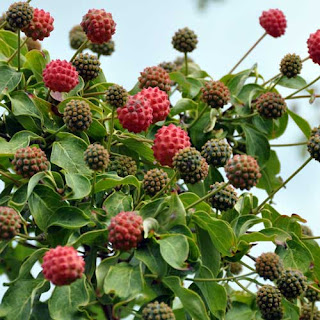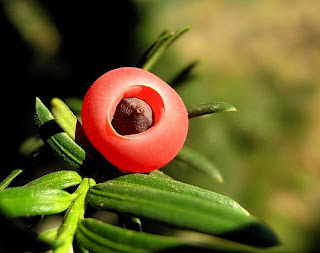When deciding to grow fruit, I often find that we often limit ourselves to just a couple, old stand-by's - the fruit everybody and their neighbor are planting: apples, peaches, pears, etc. But here in the temperate region of the United States we can grow so many other, equally valuable... and in my opinion much more exciting alternative fruits:
1.
Amelanchier species - A great midsummer fruit that is slightly smaller than the more common black currants. The fruit is a reddish-purple tint that is sweet and juicy with a distinct apple flavor. Closely related to vaccinium (blueberry), amelanchier is more commonly known as: serviceberry or Juneberry. One of the major issues you may run into is that the fruit is a beloved favorite of our feathered friends. There is however a simple solution: net off your plants, similarly to blueberries, to save some of the tasty berries for yourself.
 |
| Amelanchier alnifolia |
Edibles:
A. alnifolia - 9' shrub to 10' with the sweetest Juneberries you'll ever taste, it's also the best producer. Once established it will sucker and form a thicket
A. alnifolia semiintegrifolia - similar to the shrub above but fruit ripens a week or two later
A. laevis - a taller amelanchier reaching heights of about 30'
A. lamarckii - another tall amelanchier reaching heights of about 20'
A. stolonifera - a shorter amelanchier, often staying below 7' in height. It will sucker but at a much less rapid pace than the others.
2.
Cornus species - Dogwood
 |
| Cornus kousa |
Edibles:
C.masi - Also known as the cornelian cherry is a deciduous shrub. The fruit can be very variable in quality and size. For the best, most flavorful and juicy fruit - make sure they are fully ripened. If unripe the fruit can be very astringent.
C. kousa - Deciduous tree that is a good alternative for the
C. florida. The odd-looking fruit ripens and can be eaten raw or cooked. The skin can be a bit bitter so the best way to eat it is to bite a bit of skin off then suck out the sweet, custard-like center.
3.
Crataegus species - Known also as hawthorns, have many species that produce edible red berries about the size of cherries as well as edible leaves. The fruit tends to be slightly sweet with a strange aftertaste when eaten raw which is why they are more commonly made into delicious jams, jellies, syrups and preserves where they become much more palatable and are high in vitamin c.
Edibles:
C. arnoldiana, C. baroussana, C. douglasii, C. ellwangeriana, C. festiva, C. monogyna, C. pensylvanica, C. schraderiana, and
C. tanacetifolia to name a few
...
4.
Diospyros species - Persimmons: A genus of deciduous trees
 |
| Diospyros virginiana |
Edibles:
D. kaki - The Japanese persimmon is the most widely cultivated species, but doesn't do extremely well in Tennessee (successful plot in California). It is edible while still firm but is best when eaten after it has had a couple of days to soften.
D. virginiana -Native to the eastern United States, the American persimmon can become a very large tree. The fruit rarely becomes fully ripened on the branch, but you can collect the firm ones and let them sit and ripen fully in your home. They make a wonderful pudding or a nice, moist bread or cake. I wouldn't recommend eating until fully ripened and soft. The fruit, when not fully mature, is high in tannins and will leave a bitter taste and a feeling similar to cottonmouth.
D. lotus, D. digyna, D. discolor are a few other edible kinds of persimmon.
5.
Morus secies - Mulberry's
Edibles:
M. rubra - Commonly known as the red mulberry is the only native mulberry and when grown in their natural habitat don't have any severe issue with pests or diseases. A small red mulberry can reach 60' in height with a short trunk and spreading branches. Performance varies greatly from tree to tree, but even the trees not quite up to human standards are still an excellent permaculture option, feeding live stock for up to 3 months. The leaves are edible too!
M. alba and
M. nigra are two other commonly found, edible mulberrys.
6.
Taxus species - Also know as yew, are slow growing, evergreen plants that are very tolerant of soil and light conditions. All parts of the plant are extremely toxic, except for the sweet fruit of the
Taxus baccata.
 |
| Taxus baccata |
Edibles:
Taxus baccata - The fruit is sweet and juicy but one should avoid the seed - It's toxic if bitten into (if swallowed whole it isn't harmful). You'll know if you've bitten into the seed, it's very bitter. That being said, those who have been willing to try the fruit find it very tasty, though some are put off by the slimy texture.
Warning: If you can't clearly identify a plant, DON'T eat it. Better to be safe than sorry.
Photo Credit:
Missouri Plants
Lizer Landscape
Edgewood Garden
On Just a Couple Acres
Summagallicana





